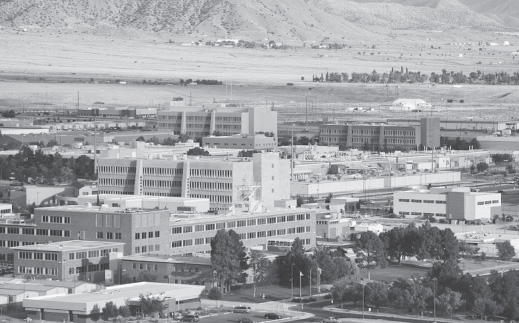Secret Journey to Planet Serpo (6 page)

A NEW PLANETARY ERA
The survival of Ebe1, what we learned from him and from the crashed discs, and our subsequent association with his planet opened up an entirely new era of our planet's history. It was the first baby step for Earth on the stage of galactic affairs, and it initiated a lasting alliance between the United States and a civilization on a distant planet. This was our antidote to the threat of the Fourth Reich in Antarctica, and it came at a perfect time. Roswell transformed American technology, expanded our cosmic vision, and opened the door to the space age.
4
LOS ALAMOS
It was sometime afterward when the thought flashed upon my mind that the disturbances I had observed might be due to an intelligent control. Although I could not decipher their meaning, it was impossible for me to think of them as having been entirely accidental. The feeling is constantly growing on me that I had been the first to hear the greeting of one planet to another.
N
IKOLA
T
ESLA
, “T
ALKING
WITH THE
P
LANETS,”
C
OLLIERS
W
EEKLY
(M
ARCH
1901)
The selection of the Los Alamos National Laboratory near Santa Fe, New Mexico, as the site to house the alien found alive at the Corona crash site, seemed at first glance to be rather strange and inappropriate. At the time of the Roswell crash, in July 1947, less than two years after the two atomic bombs had been dropped on Japan, and only four years after it was founded, the Los Alamos Laboratory was still somewhat primitive. Originally the Los Alamos Ranch School, a private school for boys who wanted to live an outdoor life, it was selected by J. Robert Oppenheimer, the director of the Manhattan Project, and approved by General Leslie Groves, and then was commandeered by the Army in November 1942 for the express purpose of designing and developing the atomic bomb. That is to say, it was officially condemned by the government so that the property could be acquired pursuant to a military purpose. In order to allow the boys to finish the fall semester, Secretary of War Henry Stimson agreed to wait until February 8, 1943, to take possession.
During the war, it was staffed primarily by high-level theoretical physicists from several different countries. Immediately after the war, in the fall of 1945, the scientific ranks were severely reduced as the major nuclear scientists returned to academia and corporate consulting, and the lower-level workers left to pursue advanced degrees. Oppenheimer resigned a few weeks after the war ended to become director of the Institute for Advanced Study at Princeton, and Norris Bradbury succeeded him as the director in October 1945. By spring 1946, only twelve hundred staff members remained, as Bradbury sought to define the new civilian role of the laboratory in the postwar world, now working closely with the nascent Atomic Energy Commission. But the exclusive focus of the laboratory in the new era continued to be the development of atomic weaponry. According to the Los Alamos website:
By the late 1940s, funding was secured to rebuild the main technical area and improve housing, as the Laboratory refined and tested fission weapons and gradually expanded the hydrogen bomb research program. Two test series, Operations CROSSROADS and SANDSTONE, were conducted in 1946 and 1948, respectively. Six nuclear weapons tests were conducted in the 1940s, allowing the nation's stockpile to grow from two bombs, in late 1945, to 170 in 1949.
Interestingly, Major Jesse Marcel, the base security officer at Roswell, had been the Army security officer for Operation CROSSROADS conducted at the Bikini Atoll. There is no evidence that any other type of R&D was conducted at the laboratory in that period. Given the limited resources available to him during the late 1940s, it seems highly improbable that Bradbury was financially able to pursue any other type of research.

Los Alamos National Laboratories, present day
PARANOIA RULES
It seems that the most important rationale for sending the sole alien survivor of the Roswell crash to Los Alamos in 1947 must have been based on trying to learn whatever they could about the advanced technology incorporated into the alien craft, and whatever other scientific information he could give them. Certainly, the theoretical physicists at the Laboratory would have been most capable of comprehending that information and possibly converting it to useful human technology. In a more perfect world, an unexpected visitor from another planet might have been sent to a top university where Earth academicians would have attempted to learn about his home world. But, only two years after a brutal, devastating war, and with the military expecting another one, advanced technology adaptable to weaponry was the main preoccupation of the U.S. government. Paranoia superseded civilized curiosity.
But from another viewpoint, that paranoia may have been fully justified, since we knew nothing about the aliens' motives. After all, this craft was evidently scrutinizing the most sensitive military installation in the world. If an alien civilization was contemplating an invasion of Earth, it would certainly begin by checking out the most powerful military capability of the most powerful nation on the planet. It is supremely logical that the military would have come to that conclusion, and that possibility alone justified sending the alien to Los Alamos. In fact, as more and more of the secret information about the Roswell crash emerged over time, it began to appear that the alien craft may indeed have been conducting a spy mission in advance of some sort of mass landing. Army Colonel Philip Corso apparently believed that when he wrote in his book,
The Day after Roswell:

Cielo supercomputer at Los Alamos
*15
The real truth behind a fifty-year history of a war that looked like the ultimate defeat of humankind . . . can now finally be told because we prevailed. It was because in the dark hours before dawn in July 1947 the army, only dimly recognizing that we were on the edge of a potential cataclysmic event, pulled the crashed spacecraft out of the desert and harvested its parts just like the inhabitants of that vehicle wanted to harvest us.
This dramatic supposition was evidently based on a top secret report that human body parts had been found on the crashed alien craft!
And then, of course, there were the security considerations. Since the government had immediately decided, right after the crash, to keep the entire matter in top secret containment, the site chosen to host the alien had to be extremely secure, and no facility was more secure, at that time, than the home of the Manhattan Project. That requirement alone ruled out a university location. Even the Pentagon itself, which was only four years old in 1947, did not have as high a level of security as Los Alamos in those early years, since the Pentagon was right in the middle of a very busy section of northern Virginia. By contrast, the only entrance to Los Alamos was over a single mountain road tucked inside a canyon.
THE FIRST MESSAGES
The major concern in dealing with the alien was, first and foremost, communication. And evidently it was believed that if the most brilliant scientists in the country could not learn to communicate with the ET, then nobody could. Furthermore, once the alien was in a secure location, other, more appropriate language personnel could be brought in, as needed, to facilitate communication and interaction. And they, of course, would be thoroughly investigated and made to sign security oaths before gaining admission.
MJ-12 decided to refer to the Roswell aliens as “Ebens.” This was simply an unimaginative derivation of EBE, standing for “extraterrestrial biological entity.” After being comfortably ensconced at Los Alamos, the alien, who was given the designation Ebe1 by MJ-12, willingly cooperated in attempting to overcome the communication barrier. But the language differences were huge and seemed insurmountable. As shown in
Close Encounters of the Third Kind,
Steven Spielberg's 1977 movie (see chapter 18), the Eben language consisted of tonal variations, and sounded almost musical. One contributor to the Serpo website described it as “high-pitched singing.” Some of the sounds were not even reproducible by the Americans. For the entire five-year period that Ebe1 remained alive, he was only able to teach the Los Alamos scientists about 30 percent of the Eben language. Anonymous reported that “Complex sentences and numbers could not be recognized.”
Ebe1 identified a piece of equipment found intact on the alien craft as a communications device for sending and receiving messages from his home planet, and he showed the scientists how to use it, but they couldn't get it to work. So, no communications with his planet were possible for five years, until just prior to his death in the summer of 1952, when one of the scientists realized that the device had to be powered by the energy source on the alien craft. When they tried that, it worked. What is very surprising about this is the fact that it was an earthling who figured that out, not the alien. Evidently, Ebe1 just wasn't very smart. Anonymous tells us that Ebe1 was a mechanic. He wasn't a scientist. Once the connection was made, the alien commenced sending messages to his planet. During the summer of 1952, he sent six messages, all of which were successfully transmitted. He was able to roughly translate the messages into English for the benefit of the Los Alamos scientists. Message #1 notified his planet that he was still alive. Message #2 told about the crash and the fact that all of his crew were killed upon impact. The third message requested that a rescue craft be sent to Earth to pick him up. At the prompting of the scientists, the fourth message suggested that a formal meeting be arranged with Earth officials, who would, of course, be American. And then we are told by Anonymous that message 5 said that the United States government had requested an exchange program. Finally, the sixth message gave the landing coordinates on Earth for any future visitation. Why this was attempted is puzzling, since Ebe1 really couldn't interpret our chronology or numbering system, and we already knew that those coordinates were probably not going to be understood by the Ebens anyway.
Ebe1 did receive some replies to his messages, but they were replies that only he understood. His attempted translations were confusing. Apparently, his planet agreed to a return visit, but the date they specified was over ten years away! Our people concluded that this must have been a mistake, but they were unable to obtain a clarification before Ebe1 died in the late summer of 1952.
In a parenthetical note from Anonymous about the exchange suggestion in message 5, he says:
It is believed, but NOT documented, that Ebe1's U.S. military caretaker had suggested to Ebe1 that an exchange program be set up which would allow our people to visit and exchange culture, scientific information, and collect astronomical [data] during a space trip by an American military team or what eventually became known as the team members.
As noted above, Ebe1 did indeed make that suggestion, but apparently there was no reply to that message. That proposal for an exchange program this early in the game was evidently purely in the interests of intelligence, and not goodwill, since the apparent spy mission of the aliens, and the discovery of human body parts on the spacecraft very likely caused us to view the Ebens as potential invaders, even though we already knew that they were not human flesh eaters! Nevertheless, that discovery probably created sufficient distrust for us to want to obtain inside information about this race that dropped onto our planet out of the skies. After all, they were caught stealthily gathering information about our military capability instead of landing at the United Nations in Manhattan and asking to be taken to our leader. Furthermore, they had the technology to reach our planet, and be assured, we were going to do whatever it took to get our hands on that technology. So, if we were able to walk around on their planet, and they were willing to let us visit, we were going to go there! The fact that the suggestion originally came from the “military caretaker” strongly implies that the proposal was based on a military consideration.
WHAT HATH LOS ALAMOS WROUGHT?
After the death of Ebe1, the Los Alamos scientists continued to try to establish communication with the Ebens' planet. They had a lexicon of the Eben written language to work from, provided by Ebe1. According to the DIA information, the scientists sent several messages in 1953 that went unanswered. And then, after an intense, eighteen-month effort to improve their syntax, they sent two messages in 1955, and finally received a reply. This was an amazing breakthrough for our planet, and an incredible accomplishment by the scientists. We had begun an actual dialogue with an alien civilization across a vast ocean of space. Far more significant than the accomplishments of Guglielmo Marconi and Alexander Graham Bell, if this event had not been so secret, it would have generated huge headlines in all the major newspapers of the world. One can imagine the celebratory scene at the Laboratory when that first alien message appeared on the communication device. Now came the job of translation. Unaided, the scientists could only comprehend about 30 percent of the message. However, with the help of language specialists from both U.S. and foreign universities, they were able to translate most of the message.

The Eben alphabet
Based on the probability that the Ebens are smarter than we are, the scientists then decided to send a reply in English, hoping the Ebens would find it easier to translate our language. They received a reply in broken English about four months later. The aliens didn't understand the concept of verbs, so their message contained only nouns and adjectives. It took several months for us to figure out the English reply. It became clear that if we sent them some basic English lessons, it might be possible to carry on a productive dialogue much faster than if we had to continue to labor over their impossibly cryptic language. This was done, and six months later Los Alamos received another English message that was much more comprehensible. They were catching on, but, according to Anonymous, “Ebens were confusing several different English words and still failed to complete a proper sentence.” But it was an auspicious beginning. The Ebens now had the basics for English communication. Certainly, if they had the ability to travel throughout the galaxy and interact with other civilizations, they could decipher the rules of a language that human fifth-graders mastered routinely. Very sensibly, the Ebens then sent us a compendium of their alphabet with what they believed to be corresponding English letters. This was turned over to the university linguists working with the Los Alamos scientists. Our language specialists struggled with it and had a very difficult time. It took another five years before we acquired a basic understanding of the Eben language, and the Ebens became somewhat, haltingly able to communicate in English.
